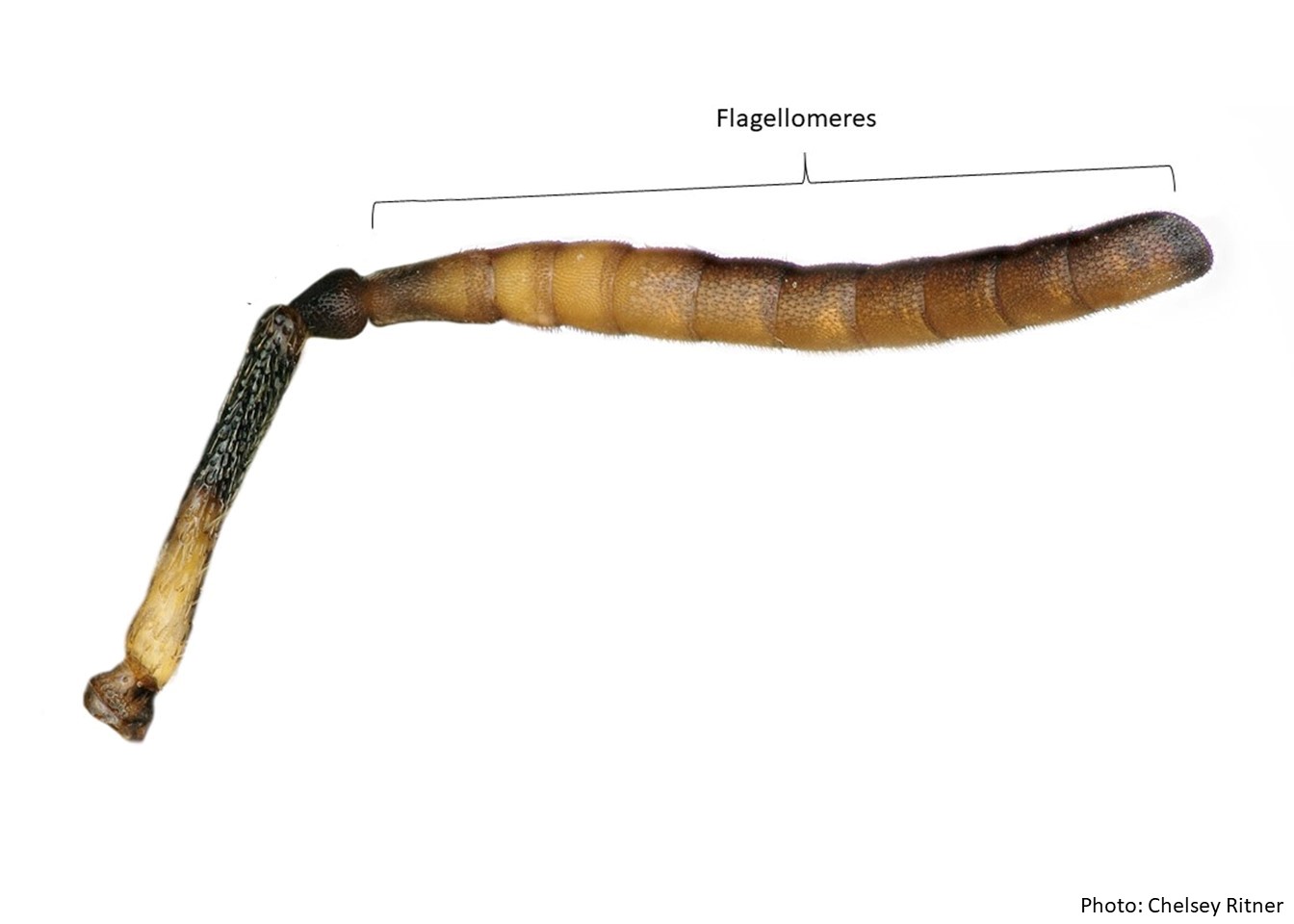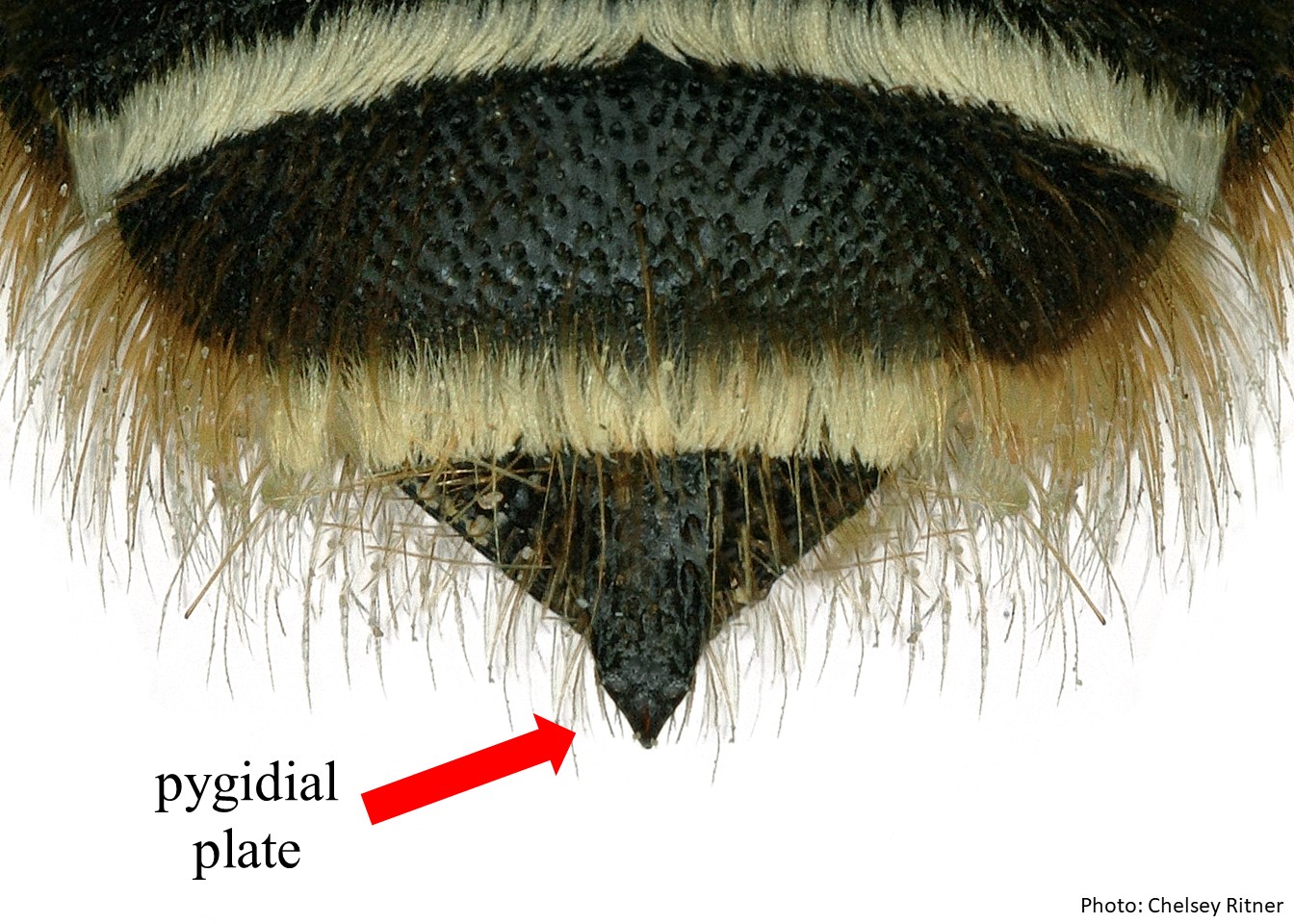Family: Megachilidae
Subfamily: Lithurginae
Tribe: Lithurgini
Genus: Lithurgopsis Fox, 1902
Subgenera: none
Common name: none
Lithurgopsis have a robust, rounded body form (Michener 2007Michener 2007:
Michener, C.D. 2007. The Bees of the World (2nd ed.). Johns Hopkins University Press, Baltimore and London, 953 pp.). They range in body length from 7.5–20 mm. They are dull black, often with pale bandsbands:
usually referring to bands of hair or bands of color that traverse across an abdominal segment
of hair on the tergaterga:
the segments on the top side of the abdomen, often abbreviated when referring to a specific segment to T1, T2, T3, T4, T5, T6, or T7 and sternasterna:
and sternasterna:
the plates on the underside of the abdomen, often abbreviated when referring to a specific segment to S1, S2, S3, S4, S5, S6, S7, or S8
 (Michener 2007Michener 2007:
(Michener 2007Michener 2007:
Michener, C.D. 2007. The Bees of the World (2nd ed.). Johns Hopkins University Press, Baltimore and London, 953 pp.). Females often have lobes or horns on their supraclypeal areasupraclypeal area:
the region of the head between the antennal sockets and clypeus, demarcated on the sides by the subantennal sutures underneath the antennae and dense ventralventral:
of, on, or relating to the underside of an animal, or segment of an animal
scopae. Lithurgopsis was previously a subgenus of Lithurgus (Gonzalez et al. 2013Gonzalez et al. 2013:
Gonzalez, V.H., M.S. Engel, and T. Griswold. 2013. The lithurgine bees of Australia (Hymenoptera: Megachilidae), with a note on Megachile rotundipennis . Journal of Melittology 11: 1ndash;19.).
Lithurgopsis contains 9 species worldwide; 7 species occur in North America north of Mexico, and 3 species occur in Argentina (Snelling 1983Snelling 1983:
Snelling, R.R. 1983. The North American species of the bee genus Lithurge (Hymenoptera: Megachilidae). Contributions to Science: Serial Publication of the Natural History Museum of Los Angeles County 343: 1ndash;11., 1986; Michener 2007Michener 2007:
Michener, C.D. 2007. The Bees of the World (2nd ed.). Johns Hopkins University Press, Baltimore and London, 953 pp.; Gonzalez et al. 2013Gonzalez et al. 2013:
Gonzalez, V.H., M.S. Engel, and T. Griswold. 2013. The lithurgine bees of Australia (Hymenoptera: Megachilidae), with a note on Megachile rotundipennis . Journal of Melittology 11: 1ndash;19.).
(modified from Michener 2007Michener 2007:
Michener, C.D. 2007. The Bees of the World (2nd ed.). Johns Hopkins University Press, Baltimore and London, 953 pp. unless otherwise stated)
 short, not or a little longer than broad, and nearly as long as second segment, which is as broad as long or longer.
short, not or a little longer than broad, and nearly as long as second segment, which is as broad as long or longer. present.
present. .
.Lithurgopsis looks similar to some Megachile, Austrothurgus, and Lithurgus, but can be distinguished by the characters listed above.
There are no known invasives.
In the U.S., Lithurgopsis spp. are primarily specialists on Cactaceae, including Opuntia spp. and Echinocactus spp., and may serve a very important role in their pollination (Wilson and Carril 2016Wilson and Carril 2016:
Wilson, J.S. and O.M. Carril. 2016. The Bees in Your Backyard: A Guide to North Americarsquo;s Bees. Princeton University Press, Princeton and Oxford, 288 pp.). This host limitation may limit Lithurgopsis to xericxeric:
a very dry habitat
regions.
Lithurgopsis spp. are solitary, although sometimes gregarious, wood-boring bees that excavate their own cavities within the wood (Rozen and Hall 2014Rozen and Hall 2014:
Rozen Jr., J.G. and H.G. Hall. 2014. Nest site selection and nesting behavior of the bee Lithurgopsis apicalis (Megachilidae: Lithurginae). American Museum Novitates 3796: 1ndash;24.). Dead rotting wood as well as firm nondegraded wood, woody stems such as Agave stalks, and occasionally man-made wood structures or wood-based materials are used (Rozen and Hall 2014Rozen and Hall 2014:
Rozen Jr., J.G. and H.G. Hall. 2014. Nest site selection and nesting behavior of the bee Lithurgopsis apicalis (Megachilidae: Lithurginae). American Museum Novitates 3796: 1ndash;24.). Their habit of burrowing into standing wooden structures can be particularly damaging over time. Their nesting habits can be peculiar compared to other megachilid bees. They typically do not line nests, but L. apicalis will occasionally lacquer the nest entrance with nectar (Rust et al. 2004Rust et al. 2004:
Rust, R.W., G. Camon, J.T. Grossa, and B.E. Vaissiegrave;re. 2004. Nesting biology and foraging ecology of the wood-boring bee Lithurgus chrysurus (Hymenoptera: Megachilidae). Journal of the Kansas Entomological Society 77: 269ndash;279.). One elongated chamber, or branch, may contain multiple provisions with brood contained one after another in a linear series (Rozen and Hall 2014Rozen and Hall 2014:
Rozen Jr., J.G. and H.G. Hall. 2014. Nest site selection and nesting behavior of the bee Lithurgopsis apicalis (Megachilidae: Lithurginae). American Museum Novitates 3796: 1ndash;24.). Wood particles are sometimes used to partition the nest chamber into multiple separate cells (Rozen and Hall 2014Rozen and Hall 2014:
Rozen Jr., J.G. and H.G. Hall. 2014. Nest site selection and nesting behavior of the bee Lithurgopsis apicalis (Megachilidae: Lithurginae). American Museum Novitates 3796: 1ndash;24.).
Lithurgopsis occurs only in the Western Hemisphere, usually in warm temperate or tropic areas. In the U.S., it occupies the dry areas of the southern and western U.S., and is rare or absent in the northeastern U.S. (Michener 2007Michener 2007:
Michener, C.D. 2007. The Bees of the World (2nd ed.). Johns Hopkins University Press, Baltimore and London, 953 pp.).
Distribution map generated by Discover Life -- click on map for details, credits, and terms of use.
Gonzalez, V.H., M.S. Engel. And T.L. Griswold. 2013. The lithurgine bees of Australia (Hymenoptera: Megachilidae), with a note on Megachile rotundipennis. Journal of Melittology 11: 1-19.
Michener, C.D. 2007. The Bees of the World (2nd ed.). Johns Hopkins University Press, Baltimore and London, 953 pp.
Rozen Jr., J.G. and H.G. Hall. 2014. Nest site selection and nesting behavior of the bee Lithurgopsis apicalis (Megachilidae: Lithurginae). American Museum Novitates 3796:1-24.
Snelling, R.R. 1986. The taxonomic status of two North American Lithurge (Hymenoptera: Megachilidae). Bulletin of the Southern California Academy of Sciences 851:29-34.
Snelling, R.R. 1983. The North American species of the bee genus Lithurge (Hymenoptera: Megachilidae). Contributions to Science: Serial Publication of the Natural History Museum of Los Angeles County 343:1-11.
Rust, R.W., G. Camon, J.T. Grossa, and B.E. Vaissière. 2004. Nesting biology and foraging ecology of the wood-boring bee Lithurgus chrysurus (Hymenoptera: Megachilidae). Journal of the Kansas Entomological Society 77: 269–279.
Wilson, J.S. and O.M. Carril. 2016. The Bees in Your Backyard: A Guide to North America’s Bees. Princeton University Press, Princeton and Oxford, 288 pp.